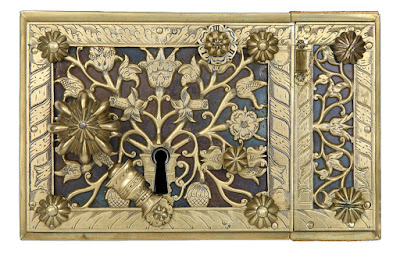 |
| Birmingham made 'detector' lock from c. 1680. V&A Collections. |
This brass lock was made in Birmingham in about 1680 by John Wilkes and is a fascinating piece in seventeenth-century technology in being able to record how may times it has been opened through the turning of the numbered dial. It would therefore ward off any potential thieves and would have been of great benefit to any business with employees. On the front are written the lines:
If I had ye gift of tongue
I would declare and do no wrong
Who ye are ye come by stealth
To impare my Master's wealth.
When a button is pressed, the man’s leg moves forwards and backwards to reveal and conceal the keyhole, and his hat is tilted to release the bolt. It is an ingenious piece of craftsmanship, and Wilkes signed it Johannes Wilkes de Birmingham. It is not the only surviving John Wilkes lock, and more are shown in the gallery below.
There were two John Wilkes', father and son, and the Wilkes who made these locks was the elder of the two, although the son was a lockmaker too. The elder John was born in about 1651 and had been a locksmith in Darlaston in Staffordshire, as noted on his marriage licence to Elizabeth Heynes.* Lock making was dominant in Darlaston and nearby Staffordshire towns and villages. Robert Plot, who wrote A Natural History of Staffordshire in 1686, described Wolverhampton door-locks ‘with brass or iron boxes so curiously polish’t, and the keys so finely wrought’.** In 1654 John Evelyn, the diarist, also described ‘a lock for a doore, that for its filing, & rare contrivances, was a masterpiece, yet made by a Country Black-Smith’ continuing that ‘a dore lock, of a tolerable price, was esteem’d a Curiositie even among forraine Princes’.*3* Although Evelyn did not note which area the 'Country Black-Smith' came from, it was likely the Black Country area of Staffordshire or Birmingham, as these were the dominant sites of lock-making outside London at this time.
 |
| 'the keys so finely wrought’, Robert Plot. The key to the detector lock, above. |
Not Simply Locks
 |
| Unsigned door lock, attributed to Wilkes as very similar to signed examples, c. 1680. Sold at Bonhams in 2010 for £7,200. |
Wilkes not only produced locks but all manner of other door furniture to create not only a secure, but a beautiful door. Locks and hinge plates are held in several museums with a similar floral design as the lock above, each one slightly different, highlighting Wilkes' hand manufacture and engraving of the designs (see gallery below). Dyrham Park, a National Trust property near Bristol and Bath, have two Wilkes locks of this design still in use, which also include a doorknob section below the lock, and decorative keyhole plate, doorknob and bolts used on the other side of the door (below, thanks to Victoria Barker).
 |
| Hinge plate with design similar to Wilkes' locks. V&A Collection. |
The Victoria and Albert Museum hold a similar signed lock to the one above and the working of it is described: 'The master of the house could select, by turning the small knob at the top of the lock, the number of bolts (1 to 4) that he wished to put into operation. When set at number four, which is maximum for locking the top four bolts are locked out by just turn of the key, but four turns of the key are required to withdraw these, i.e. one at a time. There is however literally a "sting in the tail" of the top bolt, the one last withdrawn, for it triggers off the twin anti-burglar bottom bolts, and these can only be unlocked by a reverse action of the correct key'.*5*
Similar locks (or at least parts of them) are held at Birmingham Museum and Art Gallery and the MET Museum in New York (below). The layout and workings are slightly different, but overall the designs are very similar.
GALLERY BELOW
 |
| Birmingham made 'detector' lock, John Wilkes, c. 1680. V&A. |
 |
| Birmingham lock, c. 1680. MET Museum. Attributed to John Wilkes as the lock is unsigned. |
 |
| Lock, signed by John Wilkes, c. 1680. Birmingham Museums Collection. |
 |
| A detector lock signed by Wilkes and sold at Sotheby's in 2015 for £12,500. |
Locks Attributed to Wilkes
Below is another unsigned lock very similar to the first depicted. This is very likely by Wilkes, although others may have imitated his locks.
 |
| Held at the Rijks Muesuem. |
NOTES
* 1. John Wilkes, a locksmith from Darlaston, married Elizabeth Heynes, from Sedgley, in Sedgley on 20 September 1673. The licence stated that they were both 22. Their five children were John, Mary (1674), Elizabeth (1678), Rebecca (1683), and Joseph (1689). According to wills Rebecca Wilkes married Richard Dolphin, a baker, and Mary Wilkes married Edward Burton, a short cutler.
** Robert Plot, The Natural History of Staffordshire (Oxford: The Theatre, 1686), p. 376.
*3* John Evelyn, Diary [16 July 1654]', in Memoirs, Illustrative of the Life and Writings of John Evelyn [...] 1641-1705/6, ed. by William Bray, 2nd edn (London: Henry Colburn, 1819), I, p. 279.
*4* Will and inventory of John Wilkes lockmaker of Birmingham, 25 March 1709, Staffordshire RO, B/C/11.
*5* V&A Website: https://collections.vam.ac.uk/item/O380844/lock-wilkes-john/


